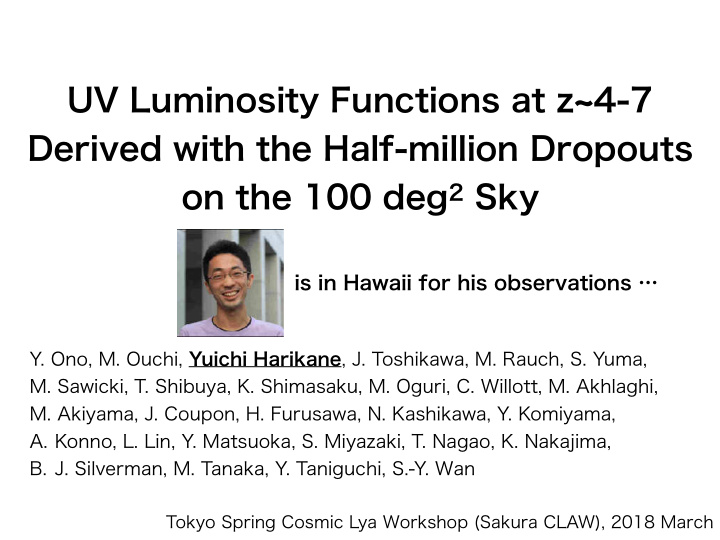



UV Luminosity Functions at z~4-7 Derived with the Half-million Dropouts on the 100 deg 2 Sky Tokyo Spring Cosmic Lya Workshop (Sakura CLAW), 2018 March Y. Ono, M. Ouchi, Yuichi Harikane , J. Toshikawa, M. Rauch, S. Yuma, M. Sawicki, T. Shibuya, K. Shimasaku, M. Oguri, C. Willott, M. Akhlaghi, M. Akiyama, J. Coupon, H. Furusawa, N. Kashikawa, Y. Komiyama, A. Konno, L. Lin, Y. Matsuoka, S. Miyazaki, T. Nagao, K. Nakajima, B. J. Silverman, M. Tanaka, Y. Taniguchi, S.-Y. Wan is in Hawaii for his observations …
Luminosity Function at Low-z scaled halo mass function UV magnitude bright end AGN feedback Number density ・Bright end of the UV luminosity function at low-z - exponential cutoff due to AGN feedback (e.g., Croton+06, Loveday+12) z~0 observations (http:/ /ned.ipac.caltech.edu/level5/March12/Silk/Silk2.html)
・Bright end of the UV luminosity function at high-z - Schechter (exponential cutoff)? or power law? - inefficient star-formation quenching feedback at high-z? z~7 excess above the exp. cutoff? Schechter Double power law ? Luminosity Function at High-z (Bowler et al. 2017; see also Bouwens et al. 2015, Finkelstein et al. 2015)
Example: z~7 → select high-z galaxy candidates ・W: g~26, r~26, i~26, z~25, y~24 ・D: g~26.5, r~26, i~26, z~25, y~24.5 ・UD: g~27, r~27, i~26.5, z~26, y~25 ■ Limiting magnitude ( 5-sigma ABmag ) = 102.7 deg 2 ■ Effective area for our study ・Wide (W) ・Deep (D) ・Ultradeep (UD) ■ Data: S16A internal release of the Subaru HSC Survey (Aihara et al. 2018) z~6 W-GAMA09H z~5 z~4 (Ono et al. 2018) Data Decl. (deg) R.A. (deg) (Harikane et al. 2018) by using the Lyman break technique.
Dropout Sample 1082 19631 45767 6730 10644 9916 38944 1500 6457 113582 5243 5989 6371 1498 612 6282 711 35963 44670 1209 D-DEEP2-3 # in total W-VVDS W-HECTOMAP W-GAMA15H W-WIDE12H W-GAMA09H W-XMM D-ELAIS-N1 94544 D-COSMOS D-XMM-LSS UD-COSMOS UD-SXDS 540011 23677 30663 104224 1990 537 Field ̶ 16 7 5 1 4 0 ̶ z-drops 14 # of i-drops # of r-drops # of g-drops # of 8 7 20 64 11 73 36 98 81 47 15 6 11 50 36 z~7 z~6 z~5 73 Total z~4 579,565
Bouwens+15 van der Burg+10 =579,565 ) ( ~50,000 ~10,000 (CFHT) HSC SSP (Hubble) Subaru This Study ・UV luminosity function: Ono et al. (2018) → This talk and others … ・protocluster study: Toshikawa et al. (2018) → Jun’s poster ・clustering analysis: Harikane et al. (2018) → Next slide ■ dropout galaxy studies x10 Dropout Sample
Clustering Analysis of Dropouts ・Angular correlation functions with unprecedentedly high statistical accuracies ・Redshift-independent relation between SFR and dark matter accretion ・See Harikane et al. 2018 for more details Harikane et al. 2018 Measuring M h and accretion rate
・In total, 358 dropouts in our sample have been identified at z>3.5 . + Five high-z galaxies are from our Subaru and Magellan follow-up. + Our previous spec. obs. results are incorporated. + Spec-z catalogs obtained by other studies are also checked. ・Contamination rates ~10% based on previous spectroscopy results. (Ono et al. 2018) Comparison with Spectroscopic Results
Bouwens+15 van der Burg+10 This Study (Ono et al. 2018) UV Luminosity Function at z=4
Bouwens+15 van der Burg+10 bright end excess Bouwens+15 Bowler+15 bright end excess This Study This Study (Ono et al. 2018) UV Luminosity Functions at z=5-6
This Study Bouwens+15 Bowler+15 bright end excess ・consistent with previous results at M UV > -23. ・appear to have an excess at M UV < -23. comparable to the number densities of AGNs (Ono et al. 2018) AGN Contamination AGN UV LFs (Jiang+09, Willott+10, Kashikawa+15)
AGN UV LFs (based on spectroscopy results) excess bright end -23 Galaxy dominated z=6 galaxies (Jiang+09, Willott+10, Kashikawa+15) galaxies and AGNs (Ono et al. 2018) Bowler+15 Bouwens+15 This Study AGN Contamination
AGN UV LFs z=6 (Ono et al. 2018) AGN dominated AGN dominated -23 Galaxy dominated -23 Galaxy dominated z=4 galaxies (Jiang+09, Willott+10, Kashikawa+15) galaxies and AGNs excess bright end Bowler+15 Bouwens+15 This Study AGN Contamination
AGN UV LFs (Jiang+09, Willott+10, Kashikawa+15) This Study Bouwens+15 Bowler+15 UV Luminosity Function at z=6 bright end excess (Ono et al. 2018)
This Study Bouwens+15 Bowler+15 2 sigma excess Schechter ・Red circles: galaxy UV LFs derived by subtracting the AGN contributions based on the galaxy fraction. ・The bright end shape cannot be explained by the Schechter function. (Ono et al. 2018) Galaxy UV Luminosity Function at z=6
This Study Bouwens+15 Bowler+15 Schechter Lensed Schechter ・Red circles: galaxy UV LFs derived by subtracting the AGN contributions based on the galaxy fraction. ・The bright end shape cannot be explained by the Schechter function. ・DPL and lensed Schechter provide better fits. (Ono et al. 2018) Double Power-Law (DPL) Galaxy UV Luminosity Function at z=6
Summary ・ ~500,000 dropout candidates at z=4-7 are identified based on the HSC SSP. ・Among them, 358 dropouts have spec-z . ・The obtained z=4-7 UV LFs span a very wide range of -26 < M UV < -14 mag , which combine our results with those from the Hubble legacy surveys. ・The bright end shapes of UV LFs cannot be explained by the Schechter functions at >2σ, and require either DPL or lensed Schechter .
Recommend
More recommend